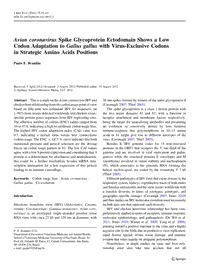
2012 Avian coronavirusSpike Glycoprotein Ectodomain Shows a Low Codon Adaptation toGallus galluswith Virus-Exclusive Cod PDF
Preview 2012 Avian coronavirusSpike Glycoprotein Ectodomain Shows a Low Codon Adaptation toGallus galluswith Virus-Exclusive Cod
Avian coronavirus Spike Glycoprotein Ectodomain Shows a Low Codon Adaptation to Gallus gallus with Virus-Exclusive Codons in Strategic Amino Acids Positions Paulo E. Branda˜o Received: 5 April 2012 / Accepted: 3 August 2012 / Published online: 19 August 2012 � Springer Science+Business Media, LLC 2012 Abstract This is a study on the Avian coronavirus IBV and chicken host-relationship from the codon usage point of view based on fifty-nine non-redundant IBV S1 sequences (nt 1–507) from strains detected worldwide and chicken tissue- specific protein genes sequences from IBV-replicating sites. The effective number of codons (ENC) values ranged from 36 to 47.8, indicating a high-to-moderate codon usage bias. The highest IBV codon adaptation index (CAI) value was 0.7, indicating a distant virus versus host synonymous codons usage. The ENC 9 GC3 % curve indicates that both mutational pressure and natural selection are the driving forces on codon usage pattern in S1. The low CAI values agree with a low S protein expression and considering that S protein is a determinant for attachment and neutralization, this could be a further mechanism besides mRNA tran- scription attenuation for a low expression of this protein leading to an immune camouflage. Keywords Codon usage bias � Avian coronavirus � Gallus gallus � Co-evolution Introduction Infectious bronchitis virus (IBV) (Nidovirales: Corona- viridae: Coronavirinae: Gammacoronavirus: Avian coro- navirus) is an enveloped single-stranded positive sense RNA virus with circa 27 kb and 120 nm in diameter, with 20 nm spikes formed by trimers of the spike glycoprotein S (Cavanagh 2007; Thiel 2005). The spike glycoprotein is a class 1 fusion protein with the two major domains S1 and S2, with a function in receptor attachment and membrane fusion, respectively, being the target for neutralizing antibodies and presenting an evolution so sensitively driven by host humoral immune-response that polymorphisms in 10–15 amino acids in S1 might give rise to different serotypes of the virus (Cavanagh 2007; Thiel 2005). Besides S, IBV genome codes for 15 non-structural proteins in the ORF1 that occupies the 50 one-third of the genome and are involved in viral replication and patho- genesis while the structural proteins E (envelope) and M (membrane) involved in virion stability and nucleoprotein (N), which associates to the genomic RNA forming the helical nucleocapsid, are coded by the remaining 30 7 kb (Thiel 2005). Different pathotypes of IBV exist that cause disease in the respiratory system, kidneys, reproductive tracts of both males and females and enteritis and the virus occurs worldwide with a massive diversity in terms of serotypes, genotypes, and geographic-specific lineages (Cavanagh 2007; Jones 2010) and thus studies on IBV molecular evolution must necessarily include data sets that represent such diversity. IBV and chicken host/virus relationship has been com- prehensively studied in terms of receptors, immune response, molecular epidemiology, and pathogenesis (De Wit et al. 2011; Jones 2010; Winter et al. 2008; Yang et al. 2009), pointing toward a positive outcome to the virus and a highly negative one to the birds due to productive virus replication, rapid disease spread, severe tissue damage, and immune evasion that relies mainly on antigenic polymorphism. Nonetheless, in depth studies on virus and host rela- tionship must also take into account that not all P. E. Branda˜o (&) Department of Preventive Veterinary Medicine and Animal Health, SchoolofVeterinary Medicine, UniversityofSa˜oPaulo,Brazil.Av. Prof. Dr. Orlando M. Paiva, 87, Cidade Universita´ria, Sa˜o Paulo, SP 05508-270, Brazil e-mail:
